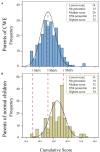Attitudes Toward Epilepsy Among Parents of Children With Epilepsy in Southern China
- PMID: 33633657
- PMCID: PMC7901895
- DOI: 10.3389/fneur.2020.602000
Attitudes Toward Epilepsy Among Parents of Children With Epilepsy in Southern China
Abstract
Purpose: To evaluate the attitudes toward epilepsy among parents of children with epilepsy (CWE) in China and identify some related factors for future interventions for parents to offer more social support for CWE. Method: The Chinese Public Attitudes Toward Epilepsy (CPATE) scale was administered to 234 parents of CWE and 203 parents of normal children in Xiangya hospital during 2019-2020. Results: The cumulative score of the parents of CWE (26.427 ± 6.688) was significantly lower than that of the normal children group (32.330 ± 7.234, p < 0.001). Subanalysis showed more positive attitudes among parents of CWE than the control group (p < 0.001) toward education (4.765 ± 1.985 vs. 6.621 ± 2.419), social life (6.556 ± 2.456 vs. 8.010 ± 2.683), marriage (9.586 ± 2.675 vs. 11.025 ± 2.900), and employment (3.876 ± 1.364 vs. 4.5123 ± 1.283). The attitudes toward epilepsy among parents of CWE with seizures in public (27.16 ± 6.66) or during sleep (27.10 ± 6.38) were more negative than those without (25.35 ± 6.62 and 25.08 ± 7.10, respectively) (p < 0.05). In addition, female and low income were negatively related to parents' attitudes toward epilepsy. Conclusions: More active policy guidance and adequate social support should be given to parents of children with seizures in public or during sleep to instruct their children to form a positive perception about epilepsy, which is expected to have a positive impact on their social abilities in the future.
Keywords: attitudes; children with epilepsy; epilepsy; future life; parents.
Copyright © 2021 Yang, Chi, Zhu, Huang, Xiang, Xiao, Tang and Feng.
Conflict of interest statement
The authors declare that the research was conducted in the absence of any commercial or financial relationships that could be construed as a potential conflict of interest.
Figures


Similar articles
-
Evaluation of anxiety, depression, and sleep quality among parents of children with epilepsy in Southern China.Epilepsy Behav. 2020 Nov;112:107340. doi: 10.1016/j.yebeh.2020.107340. Epub 2020 Aug 26. Epilepsy Behav. 2020. PMID: 32861027
-
Effects of a Nurse-Led Cognitive Behavioral Intervention for Parents of Children With Epilepsy.Pediatr Neurol. 2024 May;154:70-78. doi: 10.1016/j.pediatrneurol.2024.03.003. Epub 2024 Mar 7. Pediatr Neurol. 2024. PMID: 38552337 Clinical Trial.
-
Improving awareness, knowledge, and attitude among Malaysian parents of children with epilepsy using an Interactive Animated Epilepsy Education Programme (IAEEP).Epilepsy Behav. 2019 May;94:52-58. doi: 10.1016/j.yebeh.2019.02.008. Epub 2019 Mar 16. Epilepsy Behav. 2019. PMID: 30884408
-
A systematic review of quality of life in parents of children with epilepsy.Epilepsy Behav. 2018 May;82:38-45. doi: 10.1016/j.yebeh.2018.03.008. Epub 2018 Mar 23. Epilepsy Behav. 2018. PMID: 29579553
-
10-year research update review: psychiatric problems in children with epilepsy.J Am Acad Child Adolesc Psychiatry. 2007 Nov;46(11):1389-402. doi: 10.1097/chi.0b013e31815597fc. J Am Acad Child Adolesc Psychiatry. 2007. PMID: 18049289 Review.
Cited by
-
Epilepsy in Asian countries.Acta Epileptol. 2023 Oct 13;5(1):25. doi: 10.1186/s42494-023-00136-1. Acta Epileptol. 2023. PMID: 40217320 Free PMC article. Review.
-
Explaining the Parenting Styles of Epileptic Children: A Content Analysis.Iran J Child Neurol. 2024 Summer;18(3):65-74. doi: 10.22037/ijcn.v18i3.39664. Epub 2024 Jun 22. Iran J Child Neurol. 2024. PMID: 38988850 Free PMC article.
-
Public awareness, knowledge, and attitude toward epilepsy in Lebanon: a cross-sectional study.Front Neurol. 2024 Dec 11;15:1480960. doi: 10.3389/fneur.2024.1480960. eCollection 2024. Front Neurol. 2024. PMID: 39722692 Free PMC article.
-
Boric acid impedes glioblastoma growth in a rat model: insights from multi-approach analysis.Med Oncol. 2025 Jan 17;42(2):47. doi: 10.1007/s12032-025-02600-z. Med Oncol. 2025. PMID: 39821858 Free PMC article.
References
LinkOut - more resources
Full Text Sources
Other Literature Sources

